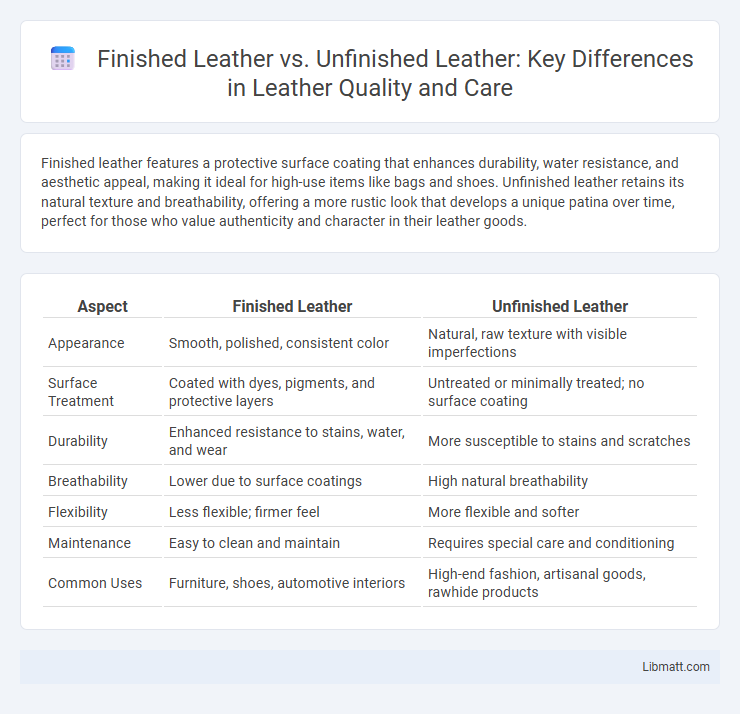Finished leather features a protective surface coating that enhances durability, water resistance, and aesthetic appeal, making it ideal for high-use items like bags and shoes. Unfinished leather retains its natural texture and breathability, offering a more rustic look that develops a unique patina over time, perfect for those who value authenticity and character in their leather goods.
Table of Comparison
| Aspect | Finished Leather | Unfinished Leather |
|---|---|---|
| Appearance | Smooth, polished, consistent color | Natural, raw texture with visible imperfections |
| Surface Treatment | Coated with dyes, pigments, and protective layers | Untreated or minimally treated; no surface coating |
| Durability | Enhanced resistance to stains, water, and wear | More susceptible to stains and scratches |
| Breathability | Lower due to surface coatings | High natural breathability |
| Flexibility | Less flexible; firmer feel | More flexible and softer |
| Maintenance | Easy to clean and maintain | Requires special care and conditioning |
| Common Uses | Furniture, shoes, automotive interiors | High-end fashion, artisanal goods, rawhide products |
Introduction to Finished and Unfinished Leather
Finished leather features a protective coating that enhances durability, color consistency, and resistance to stains, making it ideal for products needing a polished appearance. Unfinished leather maintains its natural texture and breathability, offering a more authentic look and feel that develops unique patina over time. Your choice between these types depends on whether you prioritize longevity and maintenance ease or the leather's natural characteristics and aging process.
Defining Finished Leather
Finished leather undergoes surface treatments such as dyeing, embossing, or coating to enhance durability, appearance, and water resistance, distinguishing it from unfinished leather which retains its natural texture and softness. This treated leather often boasts a consistent color and protective layer that makes it more suitable for products requiring longevity and easy maintenance. Understanding the difference helps you choose leather based on aesthetic preferences and functional needs for your projects.
Defining Unfinished Leather
Unfinished leather refers to hides that have undergone tanning but retain their natural grain, texture, and pores without additional surface treatments such as dyes or sealants. This type of leather showcases a raw, natural appearance and tends to develop character marks and patina over time, reflecting its organic origin. Commonly used in high-quality leather goods, unfinished leather offers breathability and a unique aesthetic distinct from finished leather, which includes protective coatings and uniform coloring.
Key Differences Between Finished and Unfinished Leather
Finished leather undergoes extensive processing, including dyeing, polishing, and coating, resulting in a smoother texture, enhanced durability, and resistance to stains and moisture. Unfinished leather retains its natural surface and texture, providing a more breathable, softer feel but requiring more care and developing a unique patina over time. Your choice depends on the desired aesthetics and maintenance commitment, with finished leather ideal for polished, low-maintenance items and unfinished leather favored for natural, customizable projects.
Durability and Longevity: Which Lasts Longer?
Finished leather features a protective coating that enhances resistance to water, stains, and wear, significantly extending its durability and lifespan in daily use. Unfinished leather, also known as natural or raw leather, lacks this protective layer, making it more prone to scratches and environmental damage, yet it can develop a rich patina over time, increasing its aesthetic appeal and functional longevity with proper care. Your choice between finished and unfinished leather depends on whether you prioritize immediate durability or the potential for natural aging and character development over the years.
Appearance and Texture Comparison
Finished leather features a smooth, polished surface with consistent color and a glossy or matte sheen, enhancing durability and stain resistance. Unfinished leather displays a more natural, raw texture with visible grain and variations, offering a softer, more breathable feel that develops character over time. Your choice depends on whether you prefer a refined look with easy maintenance or a rustic, unique appearance that evolves.
Maintenance and Care Requirements
Finished leather requires less maintenance due to its protective topcoat, which resists stains, moisture, and fading, making it easier to clean with just a damp cloth and mild soap. Unfinished leather, such as nubuck or suede, is more porous and sensitive, demanding regular conditioning and specialized cleaning products to prevent drying, cracking, and discoloration. Proper care of unfinished leather includes avoiding water exposure and applying protective sprays to maintain durability and appearance.
Common Uses and Applications
Finished leather is commonly used in high-end furniture, handbags, and automotive interiors due to its polished appearance and enhanced durability. Unfinished leather finds applications in jackets, gloves, and crafting projects where a natural look and breathability are preferred. Your choice between finished and unfinished leather depends on whether you prioritize aesthetic refinement or a more rustic, flexible material.
Pros and Cons of Finished vs. Unfinished Leather
Finished leather offers a durable, water-resistant surface that resists stains and maintains a consistent color, making it ideal for products requiring long-term wear and easy maintenance. Unfinished leather, also called natural or raw leather, provides a soft, breathable texture with a unique, developing patina, but it is more prone to scratches, stains, and requires regular care. Your choice depends on whether you prioritize appearance and ease of maintenance (finished) or natural feel and aging beauty (unfinished).
Choosing the Right Leather for Your Needs
Finished leather offers durability, water resistance, and a polished look, making it ideal for everyday items like bags and shoes requiring easy maintenance. Unfinished leather, also known as natural or raw leather, reveals the material's unique textures and is preferred for custom projects or products valuing breathability and a softer feel. Selecting the right leather depends on factors such as usage, aesthetic preference, and the desired level of care.
Finished leather vs unfinished leather Infographic

 libmatt.com
libmatt.com